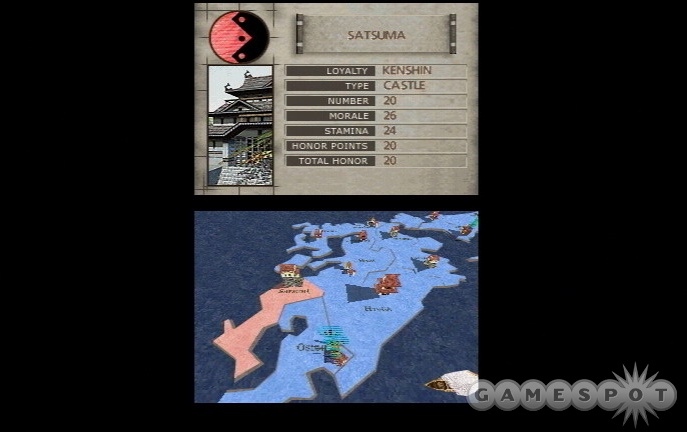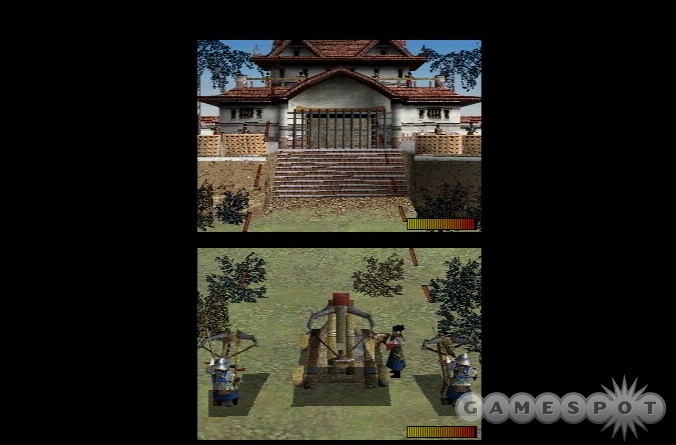Real Time Conflict: Shogun Empires
We sit down with a build of Real Time Conflict: Shogun Empires and attempt to unify feudal Japan.
Real Time Conflict: Shogun Empires is an ambitious real-time strategy game that capitalizes on the DS touch screen in a number of unique ways. Though the gameplay is reminiscent of Risk, the use of DS dual screens and the extra minigames give it a unique twist on other real-time strategy games. We sat down with a build of the game to see how it has progressed since we last saw it, at E3.
In RTC you control one of two brothers who are each attempting to unify feudal Japan under his own flag. In the beginning of the game, you can choose between Takashi, the more peaceful brother, and Kenshin, the more warlike. Since acquiring new territories can be done either through negotiation or aggression, it's possible that the brothers will be stronger using the method of coercion that is more suited to their particular personality; but that wasn't made entirely clear in the preview build that we saw.
After a brief tutorial, you are presented with a world map that represents a divided nation, split up into about 50 different-colored territories. The blue squares represent Takashi's lands; the red for Kenshin; green and yellow belong to other factions; and the gray squares are unclaimed. The objective is to maneuver the armies of either Takashi or Kenshin to other-colored squares and possess them. In the single-player mode, you get four turns each round to claim as many lands as possible, before giving the turn over to your brother, who, controlled by the computer, attempts the same. At any point during your turns, you can select any of your troops that have been randomly placed around the map. Although you begin with four armies--one on each of the map's four islands--as you encounter and defeat other armies, you will claim them for your own.

During each turn, you can move one space, to the territories adjacent to your current position. If the square is gray, then you automatically get control of it and can go on to the next turn. If the square is yellow or green, you have the option to attempt diplomacy or simply attack. There seems to be no punishment when diplomacy goes awry, so there's no harm in always trying that before fighting these armies. There are two methods of diplomacy, strong-arm and negotiate. If you're playing as Takashi, you might find that the negotiate route is more effective, though that might just be because it's a better method of diplomacy than strong-arming someone. After selecting this task, a message will appear indicating whether you succeeded or not, and the reasons for their acquiescence range from delegates who were too easily swayed to lavish feasts winning them over. If for some reason your talks fail, then you have no choice but to fight for the territory. The only time you're not allowed to try diplomacy is when you land on your brother's squares, since there seems to be only one way to get through to him.
Attacking happens in one of three ways: by pitting your ground troops against theirs, breaking down their defenses in a castle siege, or taking out one of their ships in ship-to-ship battle. Unfortunately, all three methods of combat repeat themselves far too often, and in this version we didn't see enough variety between the maps. Hopefully there are still more to come. If you're fighting enemy troops on the ground, you simply select whichever characters you want to position by using the stylus to draw a square around them. Then you click on the enemy or the location on the map you want them to move to, and they'll head off. One of the most innovative uses of the touch screen is that you can use the left trigger to swap the two screens. During these battle sequences, the top screen consists of an overhead map, and the lower allows for a more detailed view. Switching the two screens gives you the ability to move quickly to another location and then switch back so that you can make more precise movements. Sadly, combat is currently all too easy. One of the only ways to give up a victory is by choosing to simulate your fight and losing the dice roll. Frequently, during ground battles, the general from the opposing side runs away, which takes you to a horse-chase minigame. The objective is to move your horse from side to side (using the touch screen) to avoid incoming arrows, which don't seem to do much. Then you must launch your own arrows at the general, taking down his health before yours depletes. This is a nice change of pace from the standard RTS gameplay, although it simply requires button mashing.

The castle siege and ship-to-ship battle are almost identical game elements that happen with different backdrops. You must aim the crossbows of your archers to take out the opponent's archers first. This means using the touch screen to position the bow, which still feels a little unresponsive, and aiming for a location on the upper screen. There will be a line-of-sight indicator, going from the bottom screen to the top, so that you can aim more accurately.
At the end of each turn, you acquire a certain number of honor points, which you can use to build up your archers', spearmen, and swordsmen's strength, accuracy, and health. You can max them all out and then simulate the rest of the battles if you want to take over the whole map as quickly as possible. Honor points can also be used to hire a ninja, who will stealthily assist you by means of a ninja battle minigame, but his services aren't necessary because the game is still simple enough. The same goes for the general, who can be summoned in-game, but who is rarely needed.
The game's animations are still a little mechanical, but each character is clearly dressed differently, so you can be sure of what kind of troops you're dealing with at a mere glance. Though the music and sound effects are both quite good, they're a bit more dramatic than necessary for the gameplay. You'll hear the roaring crowds and clashing of swords when you send three archers to attack two enemy spearmen. Regardless, it gives the game a nice sense of ambiance. We look forward to checking out the multiplayer elements, which we didn't get to see in this version, but which promise up to eight-player Wi-Fi head-to-head. Though there were some interesting ways in which the game combines strategy elements, minigames, and touch screen compatibility, we hope to see some more improvements to the game before it comes out at the end of this month, and we will bring you more information as it is made available.
Got a news tip or want to contact us directly? Email news@gamespot.com
Join the conversation